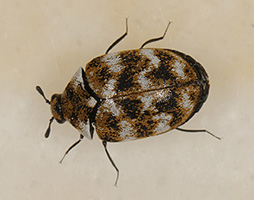ManageSafe
Least-Toxic Control of Carpet Beetle Choose a different pests

|
Identification
Pest type: Insects
In-depth Information:
It is not always possible to tell from the damage whether you are dealing with clothes moths or carpet beetles, but in general, the beetles are more likely to damage a larger area on one portion of a garment or carpet while moth damage more often appears as scattered holes with webbing.
There are a number of different types of carpet beetles; however they can all be controlled with similar methods. Black carpet beetles are uniformly black, while other carpet beetles have colored patterns on their backs; they are generally shaped like ladybugs (bed bugs are much smaller, in case you’re concerned). The carpet beetle larvae leave brown, shell-like, bristly looking cast skins when they molt, and fecal pellets that are about the size of a grain of salt.
Is it a problem?
Low-level infestations are usually of minor importance. Occasionally severe infestations can occur in natural fibers, fabrics, and foods (carpet beetles do not feed on synthetic fibers). Carpet beetles are a difficult pest because they can be widely dispersed within a home and can find food in many out of reach areas. Damage is caused primarily by the larval stage of carpet beetles. The larvae hatch in about two weeks and then feed for varying periods, depending upon species and environmental conditions.
Pest prevention practices
Remove potential habitat
Remove clutter
Eliminate the source of the infestation
Practice proper vacuuming
Prevent entry - Carpet beetles often make their way into homes by simply flying in a house while the door is open.
Because beetles prefer the dark, rearrange furniture periodically to exposure all carpeting surfaces to the light.
Monitoring and record-keeping
Adult carpet beetles lay eggs on the larval food source, such as furs and woolen fabric or carpets, or other natural, non-synthetic fibers. They prefer dark, secluded places, occasionally feeding on stored products such as certain spices and grains. The carpet beetle larvae leave brown, shell-like, bristly looking cast skins when they molt, and fecal pellets that are about the size of a grain of salt.
Non-chemical and mechanical controls
Repair holes
Remove clutter
Remove debris and habitat
Handpick and destroy
Dispose of articles and objects that are badly infested (small items can be placed in a freezer for 48 hours to kill off the beetles)
Dry clean infested clothing – steam clean items that cannot be washed
Vacuum - and dispose of vacuum waste carefully to prevent reinfestation
Biological controls
Unfortunately, biological controls are not effective for control of indoor carpet beetles.
Least-toxic chemical options as a last resort
As a least-toxic management option, boric acid can be placed into cracks and crevices where a carpet beetle infestation is extreme - around the posts of your bed/couch, in corners, etc. However, be careful to make sure it is an area where pets and children will not come into direct contact. If possible, exclude them from the room you are treating until the problem is solved and you can clean up any residues.
Chemicals to Avoid
Look at your product labels and try to avoid products containing those chemicals listed below:
(A = acute health effects, C = chronic health effects, SW = surface water contaminant, GW = ground water contaminant, W = wildlife poison, B = bee poison, LT = long-range transport)
|
Bifenthrin Deltamethrin | Etofenprox Permethrin | Piperonyl butoxide (PBO) Pyrethrins | Pyriproxyfen |
Social Media
See what other folks are saying about this, and let us know what works for you.
CREEPY CRAWLY CARPET BEETLESQuestion:Howdy! We seem to have an invasion of carpet beetles and despite a heavy and...
Posted by Beyond Pesticides on Friday, September 25, 2015
Click the post above to view and comment on Facebook, or comment directly on this site below.








